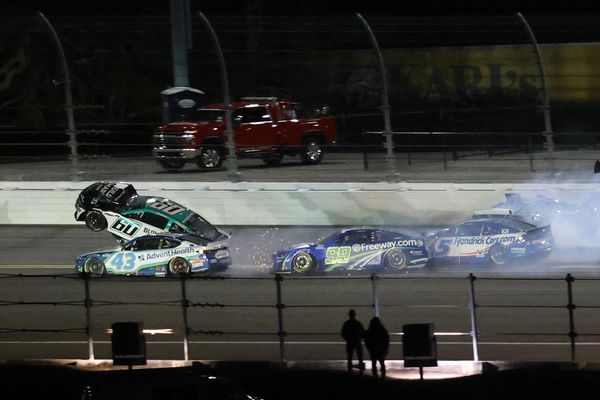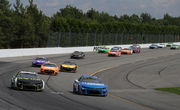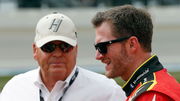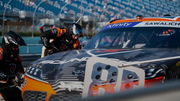
via Imago
NASCAR, Motorsport, USA DAYTONA 500 Feb 16, 2025 Daytona Beach, Florida, USA NASCAR Cup Series driver Ryan Preece 60 gets airborne after a wreck during the Daytona 500 at Daytona International Speedway. Daytona Beach Daytona International Speedway Florida USA, EDITORIAL USE ONLY PUBLICATIONxINxGERxSUIxAUTxONLY Copyright: xMarkxJ.xRebilasx 20250216_mcd_su5_271

via Imago
NASCAR, Motorsport, USA DAYTONA 500 Feb 16, 2025 Daytona Beach, Florida, USA NASCAR Cup Series driver Ryan Preece 60 gets airborne after a wreck during the Daytona 500 at Daytona International Speedway. Daytona Beach Daytona International Speedway Florida USA, EDITORIAL USE ONLY PUBLICATIONxINxGERxSUIxAUTxONLY Copyright: xMarkxJ.xRebilasx 20250216_mcd_su5_271
Is NASCAR truly fixing the problem, or are they just repeating the same mistakes? Does Slowing the Cars Make Racing Safer? Ryan Preece’s violent crash in the 2025 Daytona 500 once again put NASCAR’s safety measures under scrutiny. While Preece walked away, the crash reignited concerns about superspeedway racing and whether NASCAR’s approach to safety is truly effective.
What happened to superspeedway racing? Once unpredictable and skill-driven, it’s now a high-speed demolition derby. NASCAR’s attempt to slow the cars down has only made the wrecks worse. Preece’s terrifying crash in the 2025 Daytona 500 proved that reducing speeds doesn’t prevent accidents—it makes them more violent. “When the car took off like that, it got real quiet. All I thought about was my daughter. I’m lucky to walk away,” Preece said. “We keep beating on a door hoping for a different result. I don’t want to be the example of when it finally does get somebody.”
ADVERTISEMENT
Article continues below this ad
Daytona 500 a snooze fest without the big one?
After his crash, NASCAR responded the same way it did in 2018—by lowering speeds. But Denny Hamlin, a veteran of superspeedway chaos, isn’t buying it. He believes the real problem isn’t how fast the cars go—it’s how they race. “Let’s be a little careful with these ‘knee-jerk reactions,” Hamlin said. “That’s why we have to run 175 mph on these tracks, and it’s why we’re crashing each other so hard. I’d rather let us run 200 mph with a little more space. It would be less dangerous. I am telling you it would be.”
Hamlin argues that the existing rules, which limit car speeds to around 175 mph, inadvertently lead to tighter pack racing. This close-quarter racing increases the likelihood of aggressive maneuvers and, consequently, severe accidents. He suggests that allowing higher speeds, up to 200 mph, could provide drivers with more space on the track, potentially reducing the intensity of collisions. Hamlin emphasizes that addressing the root cause—current speed restrictions and aerodynamic packages—is essential for enhancing driver safety, rather than implementing reactive measures after incidents occur.
The logic is simple. When NASCAR forces cars into tight packs, drivers have no way to escape trouble. One mistake triggers a chain reaction, sending cars flying. Before NASCAR neutered the 2018 package, drivers could build and sustain runs, separate from the pack, and make bold moves without wrecking the entire field. The action was raw, and unpredictable—exactly what made superspeedway racing thrilling.
That changed after Jamie McMurray’s Talladega crash in 2018. His car flipped violently after hitting 203.975 mph in practice. The response? NASCAR slowed the cars down, added drag, and killed the ability to break away. Suddenly, superspeedway racing became a single-file parade or a pack-racing crash fest. Fans lost excitement, and drivers lost control of their own fate.

via Imago
DAYTONA, FL – FEBRUARY 19: Ricky Stenhouse Jr 47 JTG Daugherty Racing Kroger/Cottonelle Chevrolet and Kyle Larson 5 Hendrick Motorsports HendrickCars.com Chevrolet lead the field during the running of the NASCAR, Motorsport, USA Cup Series Daytona 500 on February 19, 2023 at Daytona International Speedway in Daytona Beach, FL. Photo by Jeff Robinson/Icon Sportswire AUTO: FEB 19 NASCAR Cup Series DAYTONA 500 Icon2302192165500
Before the rules change was announced, five-time Talladega winner Brad Keselowski described the cars as “out of control.” He added, “The cars are about five to 10 miles per hour faster than they have been here in the last two to three decades. The liftoff speed is probably a concern, not just for me but for everybody. With the cars handling the way they are, you will need to single-file out to survive this race. I think that is probably not the expectation of what we want to put on for a show. … As to whether whatever changes are made will be successful, I don’t know that, either.”
What’s your perspective on:
Should NASCAR bring back the 2018 package to restore the excitement and safety of superspeedway racing?
Have an interesting take?
Instead of adjusting safety features that fail to address the core problem, NASCAR must revisit what once worked. To fix superspeedway racing, they should adapt the original 2018 package for the Next Gen car. They need to chop and narrow the spoiler, seal off the sides, and remove the diffuser. Let the cars regain instability. Give drivers the ability to build and carry runs instead of forcing chaotic pack racing. While these are the bold changes some experts believe could work out, nothing can be said for certain. Especially, with the spec car, NASCAR might be hesitant to this change as they want a similar setup to roll out at all types of racetracks. So, it’s hard to see them roll out massive changes only for the superspeedway package.
Trending
ADVERTISEMENT
Article continues below this ad
NASCAR at a Crossroads: Will It Finally Heed the Warning Signs?
Following Ryan Preece’s violent crash, NASCAR’s senior vice president of competition, Elton Sawyer, acknowledged the severity of the incident and emphasized the organization’s commitment to analyzing and improving safety measures. Speaking on SiriusXM NASCAR Radio, Sawyer stated, “We’ll send our folks over there this morning to start looking through that, working closely with Ryan and the team and the folks at RFK to see what we can learn. And then we will, if there are things that come out of that, that we can implement going forward as we’ve done in the past, we will continue to do that.”
This response follows NASCAR’s long-standing approach of investigating major crashes and making incremental adjustments. After similar high-profile wrecks, such as Austin Dillon’s airborne crash at Daytona in 2015 and Ryan Newman’s terrifying last-lap accident in the 2020 Daytona 500, NASCAR introduced reinforced roll cages, additional roof support bars, and tweaks to the superspeedway package. However, as Hamlin and other drivers have pointed out, these reactive changes often fail to address the root cause—pack racing forced by speed restrictions.
Sawyer also noted that, despite the terrifying flip, the car did perform as expected under the circumstances. “The front stayed up for a while, but once the car started to turn, the air started to see the side of it. I’m not an aerodynamicist (and) I don’t claim to be, but I know the guys in the back will dissect that. We’ll go over this morning… our team at the racetrack… and felt like all the safety stuff did what we needed it to do,” he said. Though NASCAR believes the car’s safety features performed as intended, the accident has sparked renewed debates about safety protocols at tracks like Daytona, where the risk of cars going airborne remains high. The flip triggered concern not just about the immediate aftermath but also about future accidents if safety measures aren’t further refined.
ADVERTISEMENT
Article continues below this ad
In the aftermath of Preece’s crash, the question remains: Will NASCAR continue to make minor adjustments, or will it take a bold step toward fixing the true problem? The solution isn’t complicated. Bring back the core principles of the 2018 package. Shrink the spoiler. Seal off the sides. Remove the diffuser. Let the cars become unstable again. Give drivers control over their destiny instead of forcing them into a lottery of wrecks.
Ryan Preece is right. The next time, someone might not walk away. NASCAR needs to act before that happens.
ADVERTISEMENT
ADVERTISEMENT
ADVERTISEMENT
ADVERTISEMENT







Should NASCAR bring back the 2018 package to restore the excitement and safety of superspeedway racing?